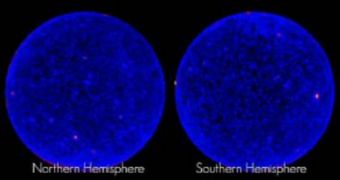The new film created by the NASA American space agency makes clever use of scientific observations made by Fermi's Large Area Telescope (LAT) in its first 87 days of operations, and depicts the Universe in a manner that has rarely been seen before. Active galaxies near and far flare up as the time passes, and the stars move gracefully across the sky.
After short periods of bursts, the level of their emissions gradually diminishes, only to return just as strong sometime later. The film was presented on April 3rd at the European Southern Observatory (ESO) headquarters in Garching, Germany, and was part of the 100 Hours of Astronomy project. This worldwide event runs until April 5th, and is designed to boost public awareness of space and the Universe. Dozens of countries and hundreds of astronomical associations participate in the events, which also host public viewing sessions on the streets.
“The movie shows counts of gamma rays seen by Fermi's LAT, and each frame shows the gamma rays collected in one day. This presentation provides a better view of sources outside our galaxy, but it's an unusual way to view the sky. One of the first things to notice in the movie is the source that arcs across the northern galactic sky. That's the sun moving along the ecliptic plane,” Fermi team Astrophysicist Elizabeth Hays, who was also the presenter of the webcast, explained.
“We see a general background of gamma rays over the whole sky. Although we don't know exactly where all of these gamma rays are coming from, we know that some of them must be the collective radiation from galaxies we are not detecting directly,” the expert added. She said that even the areas of the Universe that were extremely far away from active spots did not remain completely dark, and that sources of light illuminated them from various vantage points.
The most active sources of radiation in the Universe come from distant galaxies known as blazars. At their core, supermassive black holes, each with the mass of millions of our Suns, generate tremendous amounts of gamma rays, which they then spread all around themselves. “The strong variations in brightness that you see during the movie tell us that something about these jets has changed,” Hays shared.

 14 DAY TRIAL //
14 DAY TRIAL //